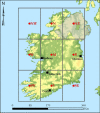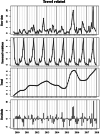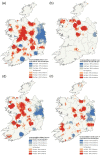Spatiotemporal epidemiology of cryptosporidiosis in the Republic of Ireland, 2008-2017: development of a space-time "cluster recurrence" index
- PMID: 34454462
- PMCID: PMC8401175
- DOI: 10.1186/s12879-021-06598-3
Spatiotemporal epidemiology of cryptosporidiosis in the Republic of Ireland, 2008-2017: development of a space-time "cluster recurrence" index
Abstract
Background: Ireland frequently reports the highest annual Crude Incidence Rates (CIRs) of cryptosporidiosis in the EU, with national CIRs up to ten times the EU average. Accordingly, the current study sought to examine the spatiotemporal trends associated with this potentially severe protozoan infection.
Methods: Overall, 4509 cases of infection from January 2008 to December 2017 were geo-referenced to a Census Small Area (SA), with an ensemble of geo-statistical approaches including seasonal decomposition, Local Moran's I, and space-time scanning used to elucidate spatiotemporal patterns of infection.
Results: One or more confirmed cases were notified in 3413 of 18,641 Census SAs (18.3%), with highest case numbers occurring in the 0-5-year range (n = 2672, 59.3%). Sporadic cases were more likely male (OR 1.4) and rural (OR 2.4), with outbreak-related cases more likely female (OR 1.4) and urban (OR 1.5). Altogether, 55 space-time clusters (≥ 10 confirmed cases) of sporadic infection were detected, with three "high recurrence" regions identified; no large urban conurbations were present within recurrent clusters.
Conclusions: Spatiotemporal analysis represents an important indicator of infection patterns, enabling targeted epidemiological intervention and surveillance. Presented results may also be used to further understand the sources, pathways, receptors, and thus mechanisms of cryptosporidiosis in Ireland.
Keywords: Clustering; Cryptosporidiosis; Cryptosporidium; Seasonality; Space–time scanning; Spatiotemporal epidemiology.
© 2021. The Author(s).
Conflict of interest statement
The authors declare they have no competing interests.
Figures













Similar articles
-
Clustering of cryptosporidiosis in Queensland, Australia, is not defined temporally or by spatial diversity.Int J Parasitol. 2020 Mar;50(3):209-216. doi: 10.1016/j.ijpara.2019.11.010. Epub 2020 Feb 29. Int J Parasitol. 2020. PMID: 32126239
-
Temporal and spatial distribution of human cryptosporidiosis in the west of Ireland 2004-2007.Int J Health Geogr. 2009 Nov 24;8:64. doi: 10.1186/1476-072X-8-64. Int J Health Geogr. 2009. PMID: 19930685 Free PMC article.
-
The epidemiology of cryptosporidiosis in New Zealand, 1997-2006.N Z Med J. 2009 Feb 27;122(1290):47-61. N Z Med J. 2009. PMID: 19319168
-
A retrospective epidemiological analysis of human Cryptosporidium infection in China during the past three decades (1987-2018).PLoS Negl Trop Dis. 2020 Mar 30;14(3):e0008146. doi: 10.1371/journal.pntd.0008146. eCollection 2020 Mar. PLoS Negl Trop Dis. 2020. PMID: 32226011 Free PMC article.
-
A review of outbreaks of cryptosporidiosis due to unpasteurized milk.Infection. 2020 Oct;48(5):659-663. doi: 10.1007/s15010-020-01426-3. Epub 2020 Apr 15. Infection. 2020. PMID: 32297163 Review.
Cited by
-
Spatio-temporal evolution of COVID-19 in the Republic of Ireland and the Greater Dublin Area (March to November 2020): A space-time cluster frequency approach.Spat Spatiotemporal Epidemiol. 2023 Jun;45:100565. doi: 10.1016/j.sste.2023.100565. Epub 2023 Jan 15. Spat Spatiotemporal Epidemiol. 2023. PMID: 37301603 Free PMC article. No abstract available.
-
A summary of cryptosporidiosis outbreaks reported in France and overseas departments, 2017-2020.Food Waterborne Parasitol. 2022 Apr 29;27:e00160. doi: 10.1016/j.fawpar.2022.e00160. eCollection 2022 Jun. Food Waterborne Parasitol. 2022. PMID: 35586547 Free PMC article.
-
An ecological study of the spatiotemporal dynamics and drivers of domestically acquired campylobacteriosis in Ireland, 2011-2018.PLoS One. 2023 Nov 17;18(11):e0291739. doi: 10.1371/journal.pone.0291739. eCollection 2023. PLoS One. 2023. PMID: 37976287 Free PMC article.
-
Sporadic Shiga Toxin-Producing Escherichia coli-Associated Pediatric Hemolytic Uremic Syndrome, France, 2012-2021.Emerg Infect Dis. 2023 Oct;29(10):2054-2064. doi: 10.3201/eid2910.230382. Emerg Infect Dis. 2023. PMID: 37735746 Free PMC article.
-
The Marine Compound Tartrolon E Targets the Asexual and Early Sexual Stages of Cryptosporidium parvum.Microorganisms. 2022 Nov 15;10(11):2260. doi: 10.3390/microorganisms10112260. Microorganisms. 2022. PMID: 36422330 Free PMC article.
References
MeSH terms
Grants and funding
LinkOut - more resources
Full Text Sources
Medical

